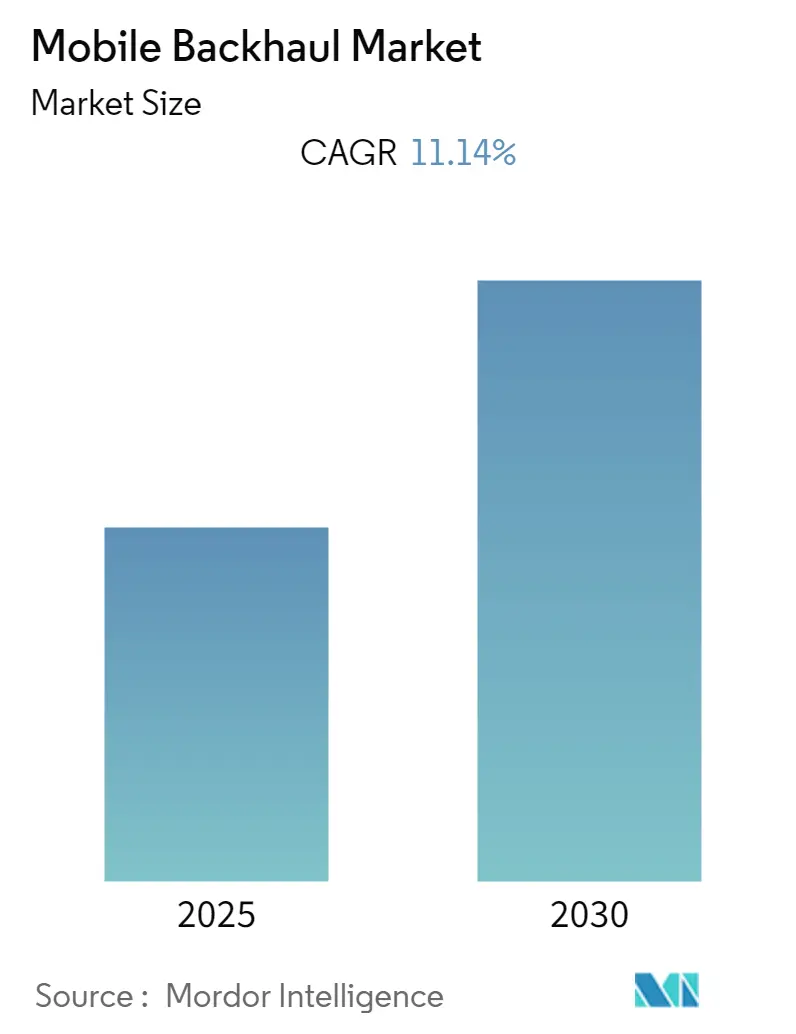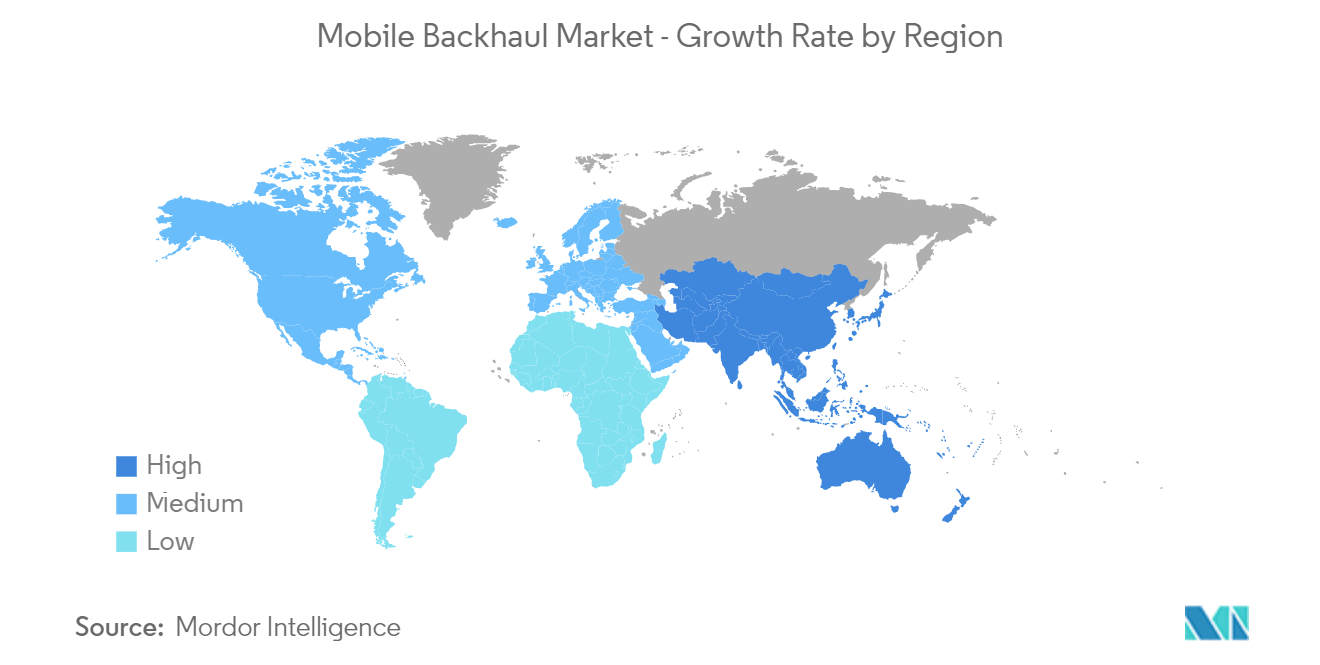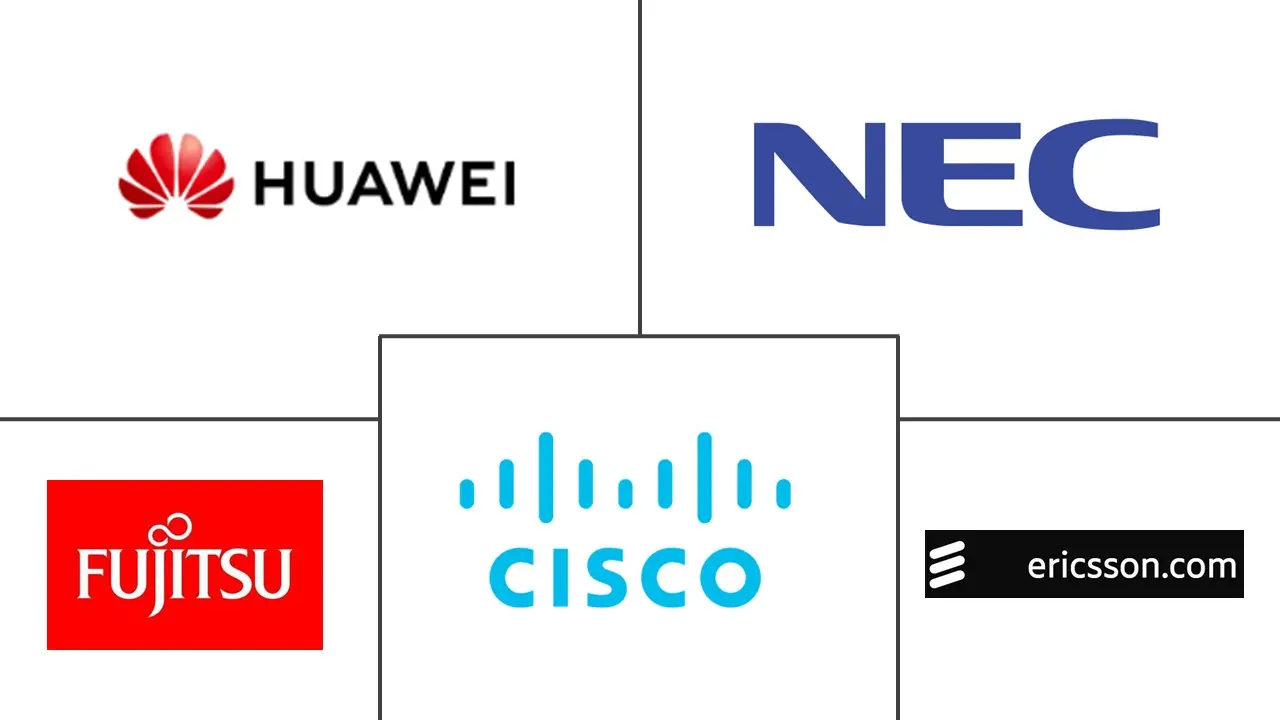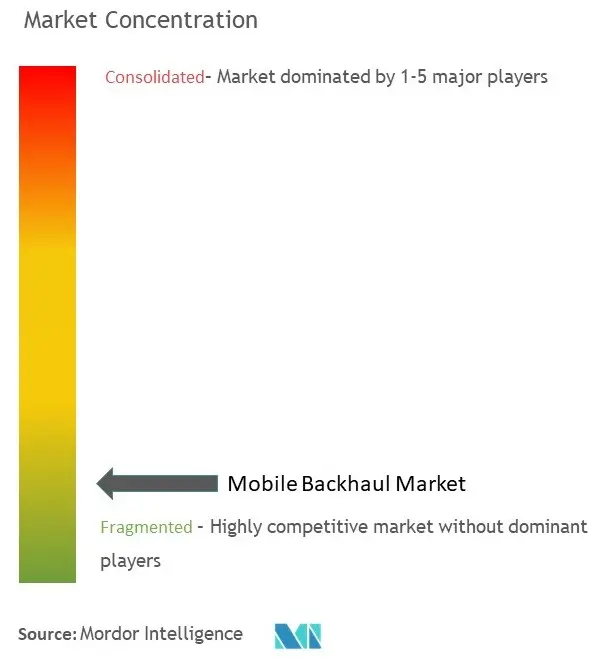
Mobile Backhaul Market Analysis
The Mobile Backhaul Market is expected to register a CAGR of 11.14% during the forecast period.
- Backhaul is the transport of voice and data traffic from a radio cell site to an edge switch at the ingress/egress point of the backbone core network. Mobile backhaul's primary purpose is to gather user data and transfer it to a network, such as an academic institution, government agency, significant institution, or the internet. It can also handle and distribute massive volumes of data, significantly improving the user experience.
- The demand for connected devices such as smartphones is increasing gradually, which drives market growth. The increasing use of point-to-point microwave transport technology is also expected to drive the growth of this market due to its offerings, such as cost-effective backhauling for high-speed voice and data services. Several factors, such as the proliferation of small cells and the high penetration of smartphones, contribute to the market's growth.
- Due to advancements in digital technology and the connectivity level of the internet, with increased dependence on streaming services, 4G networks supported majorly, streaming with AR/VR, 4k/8k video, and 360-degree videos, the 5G video content is expected to be immersive and consuming a higher proportion of the overall data traffic increase the demand of the market.
- Several technological advances are taking place on LTE, known as LTE-Advanced Pro or 4.5G, which provide enhancements such as increased peak bandwidth and energy efficiency for IoT connectivity. The peak bandwidth of 4.5G is approximately 1gbps, which is 8-10x more than regular LTE and would allow mobile devices to accommodate video traffic at 4K quality, among other things. Several industry developments result in new challenges and requirements for MNO network backhaul infrastructure.
- The demand for mobile backhaul requirements saw a new trend during the pandemic due to the growing mobile data traffic and voice. Enterprises also ramped up their digital transformation efforts to combat the effects of the health crisis. With ever-growing end-user demand for video, content, and social media, and a need to work remotely, the reliance on next-generation connectivity to cope with bandwidth-heavy traffic has always been higher. After the pandemic, the market is growing rapidly with an increased number of smartphone subscriptions and internet penetration.
Mobile Backhaul Market Trends
Growing Demand for Smartphones and Connected Devices Drives the Market Growth
- Mobile networks are being developed to respond to the growing broadband usage. Mobile data services are well on to becoming a requirement for network consumers. A backhaul service portfolio gives operators direct access to innovation and quality. The benefits of backhaul services are the ability, accessibility, and increasing data speed for smartphone users.
- Depending on local market conditions, traffic growth can be volatile between years and vary significantly between nations. Globally, the increase in mobile data traffic per smartphone can be attributed to three key drivers: increased device capabilities, data-intensive content, and data consumption as network performance continues to improve. According to Ericsson, these differences can be seen in Sub-Saharan Africa, where the average monthly mobile data usage per smartphone is estimated to be 4.6 gigabytes (GB), and the Gulf Cooperation Council (GCC) countries, where the average monthly mobile data usage per smartphone was 25 GB last year. The global monthly average consumption per smartphone is expected to be 19 GB, which is expected to reach 46 GB by the next five years.
- Globally, a significant rise in the use of connected devices, owing to the high adoption of IoT, is expected to drive the market for mobile backhaul. Mobile data traffic is expected to increase rapidly during the forecast period. According to Ericsson, the monthly mobile data traffic per device reached 26.76 GB in North America. In the Middle East and Africa, that number stood at 11.01 GB in the current year. By the next four years, it is estimated that the average monthly data traffic per device in Western Europe would reach 51.31 GB.
- Consumers continue to demand faster and more reliable internet connections as video becomes more embedded in social media applications, and consumers increasingly watch TV online. The carriers may continue to invest in their infrastructure to improve the user experience and maintain, or attempt to grow, the market share.

Asia Pacific is Expected to be the Fastest Growing Market
- As connectivity within the region increases, the cellular backhaul demand and satellite-based backhaul would keep their prominence in Asia after seeing significant growth. With new LTE licenses popping up in every country in Asia and the growth of broadband services in rural areas, there is now a strong need for satellite services everywhere, not only for coverage matters but also for the fast acquisition of new customers. The demand in Asia for cellular backhaul by satellite is certainly strong, which caters to a demand for mobile backhaul.
- Countries across Asia-Pacific are transitioning from voice-only mobile phone use to data-intensive and cloud-centric applications, including video streaming, telemedicine, e-agriculture, and distance learning. However, many countries' rural and remote areas need to be served due to geography, infrastructure reliability, and low population density challenges.
- The presence of multiple semiconductors and mobile device manufacturers helped the market, as the adoption and penetration of smartphone and mobile devices in the developing region have been high. Additionally, this has allowed supply chain presence in the region to complement the market. The ecosystem supporting the market has allowed the market to remain a rapidly growing market.
- Mobile networks continue to play an important role in increasing social and economic inclusion in India, Nepal, and Bhutan. 5G would be essential to achieving India's digital inclusion goals, particularly extending broadband to rural and distant residences. The improved mobile broadband is creating the groundwork for the government's "Digital India" vision by allowing citizens to access public services.
- According to Erisccson, the average data traffic per smartphone is expected to rise from 25 GB per month last year to approximately 54 GB per month by the next five years, representing a 14% CAGR. Total mobile data traffic in India is expected to expand at a 19% CAGR from 18 exabyte (EB) per month in the previous year to 53 EB per month by the next five years. This is due to rapid growth in smartphone users and an increase in average smartphone usage. Mobile data traffic per smartphone in South East Asia and Oceania is predicted to reach approximatly 54 GB per month in 2028, a CAGR of 28 percent, making it the fastest-growing area.

Mobile Backhaul Industry Overview
The Mobile Backhaul Market is highly fragmented due to the presence of both global players and small and medium-sized enterprises. Many small players have expertise in certain functionalities, like system or network integration, but are not big enough to provide the entire spectrum of mobile backhaul solutions. The major players in the market are Fujitsu Limited, NEC Corporation, Ericsson Inc., Huawei Technologies, and Cisco Systems Inc., among others. Players in the market adopt strategies such as partnerships, mergers, innovations, investments, and acquisitions to enhance their offerings and gain sustainable competitive advantage.
In October 2022, the New South Wales (NSW) Telco Authority chose NEC Corporation to create the first phase of an advanced 5G innovation lab as part of a new strategic collaboration. The new 5G innovation lab would provide a space for the NSW Telco Authority and public safety agencies to experiment with new technologies, demonstrate interoperability, and push the capabilities of mobile technology in the context of Public Safety Mobile Broadband (PSMB) applications. NEC has long been a significant partner of the NSW Telco Authority, supplying wireless backhaul solutions for the NSW Public Safety Network (PSN) initiative under the ITS2573 NSW Government procurement panel.
In April 2022, Nokia announced the successful demonstration of a live microwave link using the D-Band spectrum (130-175 GHz), which provides much more bandwidth than other microwave bands and serves as an ultra-high-capacity extension for 5G backhaul and fronthaul in crowded metropolitan contexts. The research, which was carried out by Nokia using Nokia Bell Labs equipment, looked into how higher frequencies above 100 GHz may enable enormous channel bandwidths and carry up to 50 times more traffic than microwave bands commonly utilized for mobile network backhaul.
Mobile Backhaul Market Leaders
-
Fujitsu Limited
-
NEC Corporation
-
Ericsson Inc.
-
Huawei Technologies
-
Cisco Systems Inc.
- *Disclaimer: Major Players sorted in no particular order
Mobile Backhaul Market News
- October 2022: Reliance Jio Infocomm Ltd. (Jio), one of India's largest telecom firms, announced long-term partnerships with Ericsson and Nokia for 5G network equipment. Jio announced the agreements with Swedish and Finnish telecom infrastructure companies were for 5G radio access network (RAN) equipment, base stations, huge MIMO antennas, and network software needed to build a 5G standalone (SA). Among other things, Jio would deploy Ericsson's RAN equipment and mobile backhaul solutions.
- August 2022: Kacific partnered with Vodafone PNG to provide mobile backhaul services in the rural region. The collaboration would expand Vodafone PNG's voice and 3G/4G data network into Papua New Guinea's remote areas to assist digital transformation throughout government, schools, enterprises, and communities. Kacific currently operates throughout the Asia Pacific, including New Zealand, Singapore, Australia, Fiji, PNG, and other Pacific Islands. The new project would use the company's capabilities to improve mobile connectivity and services in rural areas.
- April 2022: Nokia announced the successful demonstration of a live microwave link using the D-Band spectrum (130-175 GHz), which provides much more bandwidth than other microwave bands and serves as an ultra-high-capacity extension for 5G backhaul and fronthaul in crowded metropolitan contexts. The research, which was carried out by Nokia using Nokia Bell Labs equipment, looked into how higher frequencies above 100 GHz may enable enormous channel bandwidths and carry up to 50 times more traffic than microwave bands commonly utilized for mobile network backhaul.
Mobile Backhaul Industry Segmentation
Mobile backhaul is the portion of a mobile network that connects the cellular base stations to the core network, which is subsequently connected to data centers that host the content and applications accessed by mobile users. In day-to-day life, many mobile backhaul networks are using an assortment of technologies, including fiber, copper, microwave, and millimeter-wave solutions. The market comprises deployment types, such as wired and wireless, which are part of a segment of solutions and services. The market also comprises analysis based on the geographical segment, along with the impact of COVID-19 on the overall market.
The Mobile Backhaul Market is segmented by Deployment (Wired, Wireless (Point-to-Point Network, Point-to-Multipoint Network), Type (Solution and Service), and Geography (North America, Europe, Asia-Pacific, Latin America, Middle East and Africa).
The market sizes and forecasts are provided in terms of value in USD million for all the above segments.
| By Deployment | Wired | ||
| Wireless | Point-to-Point Network | ||
| Point-to-Multipoint Network | |||
| Other Wireless Networks | |||
| By Type | Solution | ||
| Services | |||
| By Geography | North America | ||
| Europe | |||
| Asia-Pacific | |||
| Latin America | |||
| Middle East & Africa | |||
Mobile Backhaul Market Research FAQs
What is the current Mobile Backhaul Market size?
The Mobile Backhaul Market is projected to register a CAGR of 11.14% during the forecast period (2025-2030)
Who are the key players in Mobile Backhaul Market?
Fujitsu Limited, NEC Corporation, Ericsson Inc., Huawei Technologies and Cisco Systems Inc. are the major companies operating in the Mobile Backhaul Market.
Which is the fastest growing region in Mobile Backhaul Market?
Asia Pacific is estimated to grow at the highest CAGR over the forecast period (2025-2030).
Which region has the biggest share in Mobile Backhaul Market?
In 2025, the Asia Pacific accounts for the largest market share in Mobile Backhaul Market.
What years does this Mobile Backhaul Market cover?
The report covers the Mobile Backhaul Market historical market size for years: 2019, 2020, 2021, 2022, 2023 and 2024. The report also forecasts the Mobile Backhaul Market size for years: 2025, 2026, 2027, 2028, 2029 and 2030.
Our Best Selling Reports
Mobile Backhaul Industry Report
Statistics for the 2025 Mobile Backhaul market share, size and revenue growth rate, created by Mordor Intelligence™ Industry Reports. Mobile Backhaul analysis includes a market forecast outlook for 2025 to 2030 and historical overview. Get a sample of this industry analysis as a free report PDF download.




